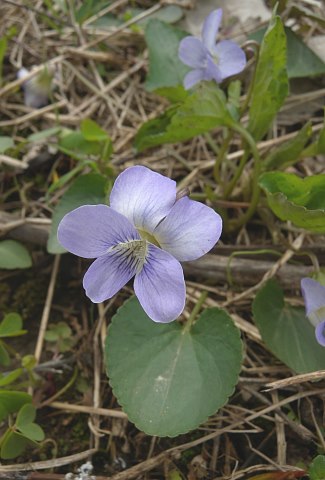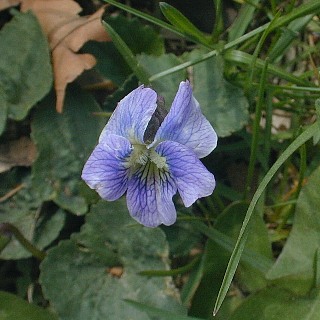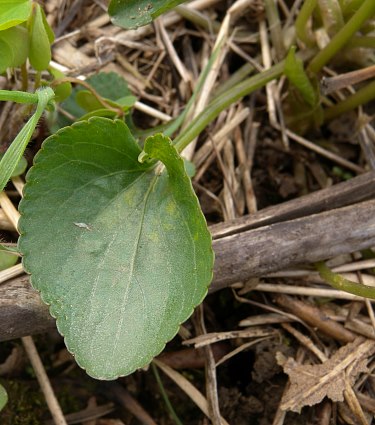Description: This is a herbaceous perennial plant with the leaves and flowers emerging directly from the rhizomes, and forming a basal rosette. A typical mature plant may be 6" across and 4" high, with the flowers slightly higher than the leaves. The leaves are individually up to 3" long and 3" across (excluding the long petioles), and vary in color from medium to dark green, depending on growing conditions. They are oval-ovate to orbicular-cordate, and crenate or serrate along the margins. The foliage is glabrous to slightly pubescent. The flowers are about ¾" across, and consist of 5 rounded petals; there are 2 upper petals, 2 lateral petals with white hairs (or beards) near the throat of the flower, and a lower petal that functions as a landing pad for visiting insects. Behind the petals, there are 5 sepals that are green and lanceolate. The petals of this form of Viola sororia are a mottled combination of blue-violet with white; from a distance, they appear pale to medium blue-violet. From the throat of the flower, there are dark blue-violet lines radiating outward (particularly on the lower petal). There is no noticeable floral scent. The blooming period occurs from mid- to late spring and lasts about 1-1½ months. During the summer, cleistogamous flowers without petals produce seeds, which are flung outward by mechanical ejection from the three-parted seed capsules. The root system consists of thick, horizontally branched rhizomes; there is a tendency to form vegetative colonies.

Cultivation:
The preference is partial sun or light shade, and moist to mesic
conditions, although full sun is tolerated if there is sufficient
moisture. The soil should be a rich silty loam or clay loam with above
average amounts of organic matter. This plant is easy to grow, and it
will spread under favorable conditions.
Habitat & Range:
The Confederate Violet is occasional to locally common in Illinois; a
Distribution Map is unavailable because the Confederate Violet is (or
was) considered a mere color form of Viola sororia.
Natural habitats include meadows, open woodlands, woodland borders,
savannas, and wooded slopes along rivers or lakes. In more developed
areas, it is sometimes found in city parks, lawns, and along hedges or
buildings.

Faunal
Associations:
The flowers have few visitors (hence the need for cleistogamous
flowers), but sometimes they attract bees and other insects. The
species Andrena viola (Violet Andrenid Bee) is an
oligolectic visitor of Viola spp. (Violets). The
caterpillars of many Fritillary butterflies (Speyeria spp.,
Boloria spp., & Euptoieta claudia)
feed on the foliage of Violets. Various upland gamebirds and small
mammals occasionally eat the seeds, including the Wild Turkey,
Bobwhite, Mourning Dove, and White-Footed Mouse. Wild Turkeys also eat
the leaves and fleshy roots of violets. Although it is not a preferred
food source, mammalian herbivores occasionally eat the foliage.
Photographic Location:
The photographs was taken at Crystal Lake Park and Judge Webber Park in
Urbana, Illinois.

Comments: The Confederate Violet is the mottled form, f. priceana, of Viola sororia. The common name of this violet refers to the resemblance of the color of its flowers to the color of Confederate uniforms during the Civil War (pale greyish blue). The typical form of this species, Viola sororia sororia (Common Blue Violet), which is more common, has flowers with a more homogenous shade of medium to dark violet. Some authorities (e.g., Mohlenbrock) classify the Confederate Violet as a distinct species, Viola priceana; in this taxonomic reclassification, it appears that no distinction has been made between the Confederate Violet and Viola sororia albiflora (White Wood Violet). I disagree with this taxonomic revision as the Confederate Violet appears to freely hybridize with both the Common Blue Violet and White Wood Violet, and they often occur together in the same habitats. This viewpoint is consistent with the taxonomic classification of the American Violet Society.